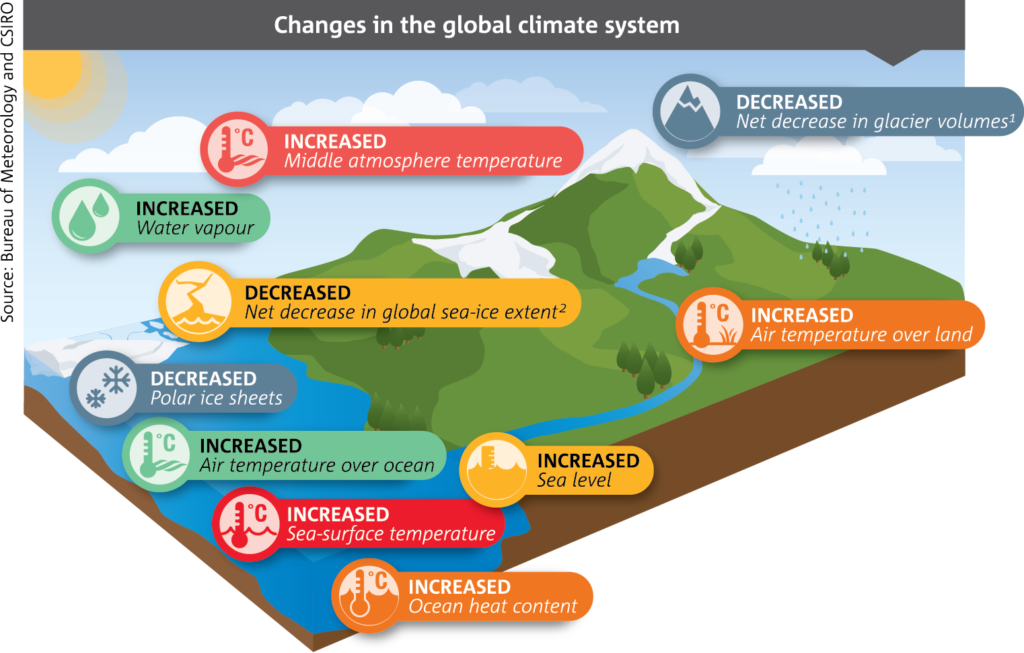A combination of coastal tide-gauge and satellite-altimeter data shows sea levels have been rising since the late 1800s.
The World Meteorological Organization reports that 2014 is on track to be possibly the world’s hottest year on record. Meanwhile, there’s been a lot of public commentary lately about the so-called “hiatus” in global surface temperature over the past 18 years, recent sea-level rise, and what it all means.
So what do CSIRO’s research and observations tell us?
They show that average surface air temperatures have continued to rise during the past two decades, but not as fast as in preceding decades. In other words, while the rate of temperature increase is lower, the temperatures themselves are not lower.
It is also important to note that when climate scientists use the term “global-mean surface temperature” they refer to near-surface air temperatures. Surface air temperature is an incomplete measure of warming of the planet; oceans store huge amounts of heat, with about 93 per cent of the extra heat stored by the Earth over the past 50 years being found in the oceans.
Changes in the global climate system indicating a world experiencing a consistent pattern of warming.*
The ocean today is warmer, and sea levels higher, than at any time since the instrumental record began. As the oceans warm, they expand and sea levels rise. Using a combination of coastal tide-gauge and satellite-altimeter data, CSIRO and others have shown that, globally, sea level has been rising since the late 1800s. Global-averaged sea level rose at an average rate of about 1.6 mm per year over the 20th Century, but this rate has accelerated to about 3 mm per year as measured by satellite altimetry and tide gauges since 1993. So the rate of sea-level rise has not slowed; it has increased.
Our measurements across the land, atmosphere and oceans show that warming has continued unabated throughout the past 18 years.
Last year was Australia’s warmest year on record, followed by 2005 and 2009. For global land and ocean temperatures, 2013 tied with 2003 as the fourth warmest year globally; and 13 of the 14 warmest years ever measured occurred in the 21st Century. As reported by the World Meteorological Organization, this year is shaping up to be the world’s warmest year – the year to the end of October is the planet’s warmest on record.
It is not unusual to see changes in the rate of surface warming. Over the past 120 years, there have been decades where global-mean air temperature has warmed more rapidly, and decades where relative cooling has occurred.
Increases in greenhouse gases provide a warming effect but, due to natural variability, climate trends based on short records are very sensitive to the beginning and end dates, and do not reflect long-term climate trends.
The rate of warming in any shorter period fluctuates because of factors such as short-term natural variability, ocean absorption of heat from the atmosphere, volcanic eruptions, changes in the 11-year solar cycle, and so on. This does not change any conclusion about the long-term trend of warming due to human activities, which have increased the concentration of greenhouse gases in the atmosphere.
CSIRO research has shown that there is less than 1 chance in 100,000 that global mean air temperature over the past 60 years would have been as high without human-caused greenhouse gas emissions. That is, the probability of global temperature increases being due to human activity exceeds 99 per cent.
The world is not cooling.
—
*Note (1) net increase in glacier volumes have regional variation (almost all glaciers worldwide losing mass but some gaining) but overall net loss; and (2) net decrease in global sea-ice extent has regional variation (over the period 1979–2012 it is very likely that the annual mean Arctic sea-ice extent decreased 3.5 to 4.1% per decade, and it is very likely that the annual mean Antarctic sea ice extent increased by 1.2 to 1.8% per decade) but overall net loss. Source: CSIRO and Bureau of Meteorology.
This article was originally published in The Canberra Times.




17th December 2014 at 1:00 pm
As you say John, you can’t fault the logic, but you note I don’t offer an alternative for the correlation between rising CO2 levels and temperatures [my added comment: but only since about 1950]. I don’t actually need to for that goal to be achieved; that goal stands alone. However, you should note there was a 50% faster recorded increase in temperature in the period 1905 to 1940 – when there were lower CO2 levels.
So, yes. It is just a coincidence; Earth’s temperature was rising naturally in this period where Man happens to be burning fuels causing large CO2 levels. One will see lots of coincidences if one looks over enough periods. One should also note from Vostok ice-core data (over the past 420,000 years) that Earth has periodically had temperatures about 2C higher than now but the CO2 levels only reached to 290ppm (cf 400ppm now). How does AGW explain that!?
As I said in my original post, I was only addressing CO2’s greenhouse properties – and found that they are not relevant above 140ppm. Yes, I can explain the current and past temperatures and CO2 levels (which AGW cannot), but I prefer to deal with one debate at a time, thanks.
[My theory can also explain that El Nino – and various other weather events, eg the current and previous Philippine hurricanes, and the 2011 Qld floods – arise from the same mechanism. Unsurprisingly, my theory is different from the current so-called theory for El Nino; it’s currently largely a description only of the event – and has zero predictive ability.]
16th December 2014 at 1:18 pm
I’m glad there are some scientists sufficiently involved to continue with this debate, but for those of us not keeping up with the science we’re forced to fall back on some relevant details. We know that virtually everyone working in the climate field agrees with the basic premise of AGW, as do thousands of others working in other fields who are observing the same trend. In terms of human knowledge then, AGW is about as well established as the theory of gravity or the theory of electricity. We also know that there are vested interests keep to keep alive the myth that there is some doubt about AGW, and that there are trolls out there doing their bidding on forums such as this. On that basis I see the above debate as an interesting distraction but lets not get to odistracted from the main game which is working on our response to a warmer planet rather than still talking about whether it’s happening or not.
5th December 2014 at 6:32 am
RE: Peter – It’s been recently shown that atmospheric warming due to increasing CO2 does indeed reach a saturation point (1), we now see that more thermal radiation is escaping back into space than has been predicted in most climate models if the observed warming was due to greenhouse gases alone (Spencer and Braswell, 2011). BUT we have to remember how strong the indirect effects of CO2 heating are as well due to associated increased levels of water vapor, a very potent greenhouse gas. NASA estimates that the warming effect of water vapor is potentially double that of CO2 as it increases in our atmosphere (2). On top of that is the effect of albedo and the very strong impact earth’s albedo has on radiation absorption and local/global heat balances.While the globe’s albedo is naturally dynamic due to seasonality humans have had a significant impact on land and sea surface cover changes (3). So while the warming of our planet is very multi-faceted (as this article nicely demonstrates) we have to remember that CO2 is definitely NOT innocent in the climate forcing effects, both directly, and arguably more importantly, indirectly.
1. http://www.forbes.com/sites/jamestaylor/2011/07/27/new-nasa-data-blow-gaping-hold-in-global-warming-alarmism/
2. http://www.nasa.gov/topics/earth/features/vapor_warming.html)
3. http://www.skepticalscience.com/earth-albedo-effect.htm
5th December 2014 at 11:15 am
Thanks for your reply.
I’m simply testing CO2’s greenhouse properties to see if it can indeed affect temperatures. That is after all, the basis of AGW, and it really has not been checked.
Looking at the thermal radiation escaping into space is simply another, more complicated way, of saying the Earth’s surface temperature has increased – which I am not disputing. What that does not address is the cause of that increase.
CO2 can have NO indirect heating effects if it no longer has a direct heating effect. And it can have no direct heating effect if its concentration is so high that it has already absorbed all the IR energy in its wavebands – which it did when it exceeded ca 140ppm. (One can work this out from IR measurements of S.D.Lord at Gemini Observatory, 1992.)
16th December 2014 at 10:22 pm
Can’t argue with your logic, except that you don’t offer an alternative explanation for the rise in global temperatures, both atmospheric and oceanic, which uniquely parallels the rise in CO2 concentration. Just a coincidence? Ok, but what else coincides?
4th December 2014 at 3:09 pm
I wonder where the flaw is in this irrefutable logic?
5th December 2014 at 8:24 am
In the chequebooks of the mining companies, I’d wager.
4th December 2014 at 12:16 pm
There’s a big leap in finding the measured global temperatures have increased over past decades then consequently finding …
“CSIRO research has shown that there is less than 1 chance in 100,000 that global mean air temperature over the past 60 years would have been as high without human-caused greenhouse gas emissions. That is, the probability of global temperature increases being due to human activity exceeds 99 per cent.”
Certainly the greenhouse gas CO2 has been increasing, almost definitely due to mankind’s efforts, but what QUANTITATIVE effect does that have? (The IPCC has a large range of guesses in the models it shows.) The relative heat absorbing properties of Greenhouse gases diminish with increasing concentrations – Beer-Lambert Law. As ground-based IR measurements show that CO2 has already absorbed its wavebands’ quota, I reckon that CO2 cannot contribute AT ALL to global warming.
[BTW: Why does this Australian CSIRO site write in English (US) rather than English Australian)?]
4th December 2014 at 4:29 pm
Peter,
Beer-Lambert law: Absorbance = constant x path length x concentration (see chemistry text book). The constant depends on the molecule in question and the path length is the distance the light has to travel through. It’s linear. As concentration increases, absorbance increases indefinitely. This is why concentrated bottles of food colouring are darker than a few drops in a glass of water.
The greenhouse effect operates by some IR emitted from the surface of the earth being absorbed by CO2. When this absorbed heat is re-emitted some of it is sent back to the surface of our planet – rather than all the heat escaping into space. There is no ‘quota’ or upper limit of energy that can be absorbed by the gas. Heat isn’t stored in the CO2 molecules, rather CO2 basically operates like a (very inefficient) mirror, or a black sheet of plastic sitting in the sun, or even like glass in a green house…
Mike
5th December 2014 at 11:00 am
1. You’re talking about absorbance, the exponent in the negative exponential equation that is Beer-Lambert. The transmission diminishes as the negative exponential. (It doesn’t actually fall to zero but becomes immeasurably small). That point is about 140ppm for atmospheric CO2.
2. The re-emitted heat cannot reach Earth as it is absorbed by the higher concentrations of CO2 at lower altitudes.